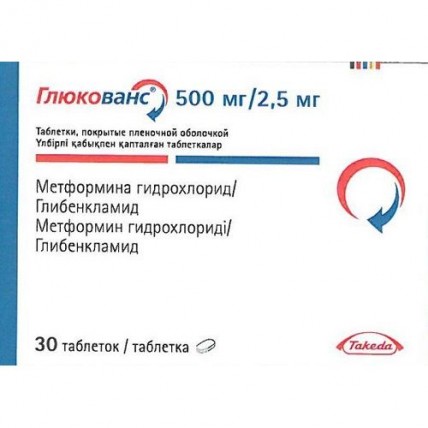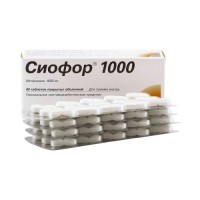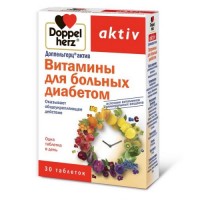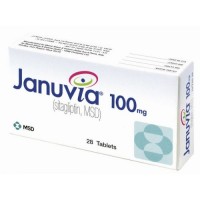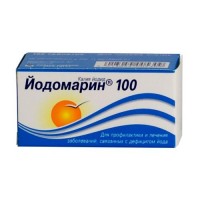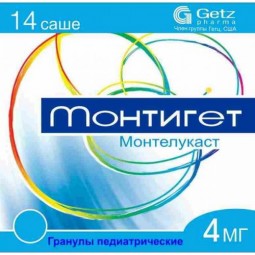Glucovance® (Glyburide/Metformin) 500mg/2.5 mg (30 tablets)
- $20.90
Sku:
7496c797cb0b
Glucovance® is a fixed-dose combination therapy containing two anti-hyperglycemic compounds, metformin hydrochloride and glibenclamide. It is indicated for the treatment of type 2 diabetes in adults, as replacement for previous combination therapy with metformin and glibenclamide in patients whose glycaemia is stable and well-controlled. The advanced tablet technology of Glucovance® improves glibenclamide absorption, and provides greater reduction of HbA1c than the free combination of glibenclamide and metformin, especially in more severe hyperglycemia.
Structure
Active ingredients: glibenclamide + metformin hydrochloride
Indications
Type 2 diabetes mellitus in adults:
in case of ineffectiveness of diet therapy, exercise and previous therapy with metformin or sulfonylurea derivatives;
to replace previous therapy with two drugs (metformin and a sulfonylurea derivative) in patients with stable and well-controlled glycemic levels.
Contraindications
hypersensitivity to metformin, glibenclamide or other sulfonylurea derivatives, as well as to excipients;
type I diabetes mellitus;
diabetic ketoacidosis, diabetic precoma, diabetic coma;
renal failure or impaired renal function (Cl creatinine
acute conditions that can lead to changes in kidney function: dehydration, severe infection, shock, intravascular administration of iodine-containing contrast media (see "Special instructions");
acute or chronic diseases accompanied by tissue hypoxia: heart or respiratory failure, recent myocardial infarction, shock;
liver failure;
porphyria;
pregnancy;
period of breastfeeding;
simultaneous administration of miconazole;
extensive surgical operations;
chronic alcoholism, acute alcohol intoxication;
lactic acidosis (including history);
adherence to a hypocaloric diet (
It is not recommended to use the drug in persons over 60 years of age who perform heavy physical work, which is associated with an increased risk of developing lactic acidosis.
Glucovance® contains lactose, therefore its use is not recommended for patients with rare hereditary diseases associated with galactose intolerance, lactase deficiency or glucose-galactose malabsorption syndrome.
With care: febrile syndrome, adrenal insufficiency, hypofunction of the anterior lobe of the pituitary gland, thyroid disease with uncompensated dysfunction.
Side effects
Metabolic disorders: hypoglycemia (see "Overdose", "Special instructions"). Rarely - attacks of hepatic porphyria and cutaneous porphyria; very rarely - lactic acidosis (see "Special instructions"). Decreased absorption of vitamin B12, accompanied by a decrease in its concentration in the serum with prolonged use of metformin. When detecting megaloblastic anemia, it is necessary to take into account the possibility of such an etiology. Disulfiram-like reaction with alcohol consumption.
Laboratory indicators: infrequently - an increase in serum urea and creatinine concentrations from an average to a moderate degree; very rarely - hyponatremia.
On the part of the circulatory and lymphatic systems: these adverse events disappear after the drug is discontinued. Rarely - leukopenia and thrombocytopenia; very rarely - agranulocytosis, hemolytic anemia, bone marrow aplasia and pancytopenia.
From the nervous system: often - taste disturbance (metallic taste in the mouth).
From the side of the organs of vision: at the beginning of treatment, temporary visual impairment may occur due to a decrease in blood glucose.
From the gastrointestinal tract: very often - nausea, vomiting, diarrhea, abdominal pain and lack of appetite. These symptoms are more common at the beginning of treatment and in most cases go away on their own. To prevent the development of these symptoms, it is recommended to take the drug in 2 or 3 doses; a slow increase in the dose of the drug also improves its tolerance.
On the part of the skin and subcutaneous tissue: rarely - skin reactions such as itching, urticaria, maculopapular rash; very rarely - cutaneous or visceral allergic vasculitis, polymorphic erythema, exfoliative dermatitis, photosensitivity.
Immunological reactions: very rarely - anaphylactic shock. Cross-hypersensitivity reactions to sulfonamides and their derivatives may occur.
Hepatobiliary disorders: very rarely - abnormal liver function indicators or hepatitis, requiring discontinuation of treatment.
Interaction
Contraindicated combinations
Glibenclamide-related
Miconazole: can provoke the development of hypoglycemia (up to the development of coma).
Associated with the use of metformin
Iodine-containing contrast agents: depending on the renal function, the drug should be discontinued 48 hours before or after intravenous administration of iodine-containing contrast agents.
Combinations not recommended
Associated with the use of sulfonylurea derivatives
Alcohol: It is very rare that an antabuse reaction (alcohol intolerance) is observed while taking alcohol and glibenclamide. Alcohol intake can increase the hypoglycemic effect (by inhibiting compensatory reactions or delaying its metabolic inactivation), which can contribute to the development of hypoglycemic coma. During the period of treatment with Glukovans®, you should avoid taking alcohol and drugs containing alcohol.
Phenylbutazone increases the hypoglycemic effect of sulfonylurea derivatives (replacing sulfonylurea derivatives at the sites of protein binding and / or reducing their elimination). Preferable use other anti-inflammatory drugs that show fewer interactions, or warn the patient about the need for self-monitoring of glycemic levels; if necessary, the dose should be adjusted with the joint use of the anti-inflammatory agent and after its termination.
Glibenclamide-related
Bosentan: in combination with glibenclamide increases the risk of hepatotoxic effects. It is recommended that you avoid taking these drugs at the same time. The hypoglycemic effect of glibenclamide may also decrease.
Associated with the use of metformin
Alcohol: The risk of developing lactic acidosis is increased with acute alcohol intoxication, especially in the case of fasting or poor nutrition, or liver failure. During the period of treatment with Glukovans®, you should avoid taking alcohol and drugs containing alcohol.
Combinations requiring caution
Associated with the use of all hypoglycemic agents
Chlorpromazine: in high doses (100 mg / day) causes an increase in glycemic levels (decreasing insulin release). Precautions: the patient should be warned about the need for self-monitoring of glucose in the blood and, if necessary, adjust the dose of the hypoglycemic agent during the simultaneous use of the antipsychotic and after the termination of its use.
GCS and tetracosactide: an increase in blood glucose levels, sometimes accompanied by ketosis (GCS causes a decrease in glucose tolerance). Precautions: the patient should be warned about the need for self-monitoring of glucose in the blood and, if necessary, adjust the dose of the hypoglycemic agent during the simultaneous use of GCS and after the termination of their use.
Danazol: has a hyperglycemic effect. If it is necessary to treat with danazol and when you stop taking the latter, you need to adjust the dose of Glukovans® under the control of glycemic levels.
β2-adrenergic agonists: by stimulating β2-adrenergic receptors, they increase the concentration of glucose in the blood. Precautions: it is necessary to warn the patient and establish a control of the glucose content in the blood, transfer to insulin therapy is possible.
Diuretics: an increase in blood glucose. Precautions: the patient should be warned about the need for self-monitoring of blood glucose; it may be necessary to adjust the dose of the hypoglycemic agent during simultaneous use with diuretics and after the termination of their use.
ACE inhibitors (captopril, enalapril): The use of ACE inhibitors helps to reduce blood glucose. If necessary, the dose of Glukovans® should be adjusted during concomitant use with ACE inhibitors and after the termination of their use.
Associated with the use of metformin
Diuretics: lactic acidosis that occurs when taking metformin against the background of functional renal failure caused by taking diuretics, especially loop diuretics.
Glibenclamide-related
β-blockers, clonidine, reserpine, guanethidine and sympathomimetics mask some of the symptoms of hypoglycemia: palpitations and tachycardia; most nonselective β-blockers increase the incidence and severity of hypoglycemia. The patient should be warned about the need for self-monitoring of blood glucose, especially at the beginning of treatment.
Fluconazole: increased T1 / 2 of glibenclamide with possible manifestations of hypoglycemia. The patient should be warned about the need for self-monitoring of blood glucose; it may be necessary to adjust the dose of hypoglycemic drugs during concomitant treatment with fluconazole and after discontinuation of its use.
Other interactions: combinations to take into account
Glibenclamide-related
Desmopressin: Glucovance® may reduce the antidiuretic effect of desmopressin.
Antibacterial drugs from the sulfonamide group, fluoroquinolones, anticoagulants (coumarin derivatives), MAO inhibitors, chloramphenicol, pentoxifylline, hypolipidemic drugs from the fibrate group, disopyramide: the risk of hypoglycemia during the use of glibenclamide.
How to take, course and dosage
Inside.
The dose of the drug is determined by the doctor individually for each patient, depending on the level of glycemia.
The initial dose is 1 tablet of Glukovans® 2.5 + 500 mg or 5 + 500 mg once a day. To avoid hypoglycemia, the starting dose should not exceed the daily dose of glibenclamide (or the equivalent dose of another previously taken sulfonylurea drug) or metformin if used as first-line therapy. It is recommended to increase the dose by no more than 5 mg glibenclamide + 500 mg metformin per day every 2 or more weeks to achieve adequate blood glucose control.
Substitution of previous combination therapy with metformin and glibenclamide: the initial dose should not exceed the daily dose of glibenclamide (or equivalent a second dose of another sulfonylurea drug) and metformin previously taken. Every 2 or more weeks after the start of treatment, the dose of the drug is adjusted depending on the level of glycemia.
The maximum daily dose is 4 tablets. the drug Glukovans® 5 + 500 mg or 6 tablets. the drug Glukovans® 2.5 + 500 mg.
Dosage regimen
The dosage regimen depends on the individual prescription.
For dosages of 2.5 + 500 mg and 5 + 500 mg:
1 time a day, in the morning during breakfast, with the appointment of 1 table. in a day;
2 times a day, morning and evening, with the appointment of 2 or 4 tablets. in a day.
For dosage 2.5 + 500 mg:
3 times a day, morning, afternoon and evening, with the appointment of 3, 5 or 6 tablets. in a day.
For a dosage of 5 + 500 mg:
3 times a day, morning, afternoon and evening, with the appointment of 3 tablets. in a day.
The tablets should be taken with meals. Each dose of the drug should be accompanied by a meal with a sufficiently high carbohydrate content to prevent hypoglycemia.
Elderly patients
The dose of the drug is selected based on the state of renal function. The initial dose should not exceed 1 table. the drug Glukovans® 2.5 + 500 mg. Renal function should be regularly assessed.
Children
Glukovans® is not recommended for use in children.
Special instructions
Against the background of treatment with Glukovans®, it is necessary to regularly monitor the level of fasting and after meals.
Lactic acidosis
Lactic acidosis is an extremely rare but serious (high mortality in the absence of urgent treatment) complication that can arise from the accumulation of metformin. Cases of lactic acidosis in patients treated with metformin occurred mainly in patients with diabetes mellitus with severe renal failure.
Other associated risk factors should also be considered, such as poorly controlled diabetes, ketosis, prolonged fasting, excessive alcohol consumption, liver failure, and any condition associated with severe hypoxia.
The risk of developing lactic acidosis should be taken into account when non-specific signs appear, such as muscle cramps, accompanied by dyspeptic disorders, abdominal pain and severe malaise. In severe cases, there may be acidotic dyspnea, hypoxia, hypothermia, and coma.
Diagnostic laboratory parameters are: low blood pH, plasma lactate concentration above 5 mmol / L, increased anion gap, and lactate / pyruvate ratio.
Hypoglycemia
Since Glukovans® contains glibenclamide, taking the drug is accompanied by the risk of hypoglycemia in the patient. Gradual dose titration after initiation of treatment may prevent hypoglycemia. This treatment can only be prescribed to a patient adhering to a regular meal regimen (including breakfast).
It is important that carbohydrate intake is regular, as the risk of hypoglycemia increases with late meals, insufficient or unbalanced carbohydrate intake. The development of hypoglycemia is most likely with a hypocaloric diet, after intense or prolonged physical activity, while drinking alcohol or taking a combination of hypoglycemic agents.
Due to the compensatory reactions caused by hypoglycemia, sweating, fear, tachycardia, hypertension, palpitations, angina pectoris, and arrhythmias can occur. The latter symptoms may be absent if hypoglycemia develops slowly, in the case of autonomic neuropathy, or while taking β-blockers, clonidine, reserpine, guanethidine or sympathomimetics.
Other symptoms of hypoglycemia in diabetic patients may include headache, hunger, nausea, vomiting, severe fatigue, sleep disturbance, agitation, aggression, impaired concentration and psychomotor reactions, depression, confusion, speech impairment, visual impairment, tremors, paralysis and paresthesia, dizziness, delirium, convulsions, somnolence, unconsciousness, shallow breathing, and bradycardia.
Careful prescribing, dose selection, and proper patient instructions are important to reduce the risk of hypoglycemia. If the patient has repeated episodes of hypoglycemia, which are either severe or associated with ignorance of the symptoms, treatment with other hypoglycemic agents should be considered.
Factors contributing to the development of hypoglycemia:
simultaneous consumption of alcohol, especially during fasting;
refusal or (especially for elderly patients) inability of the patient to interact with the doctor and follow the recommendations set out in the instructions for use;
poor diet, irregular food intake, fasting, or changes in diet;
imbalance between exercise and carbohydrate intake;
renal failure;
severe liver failure;
overdose of the drug Glukovans®;
certain endocrine disorders: insufficiency of the function of the thyroid gland, pituitary gland and adrenal glands;
simultaneous administration of certain medications.
Renal and hepatic inadequacy
Pharmacokinetics and / or pharmacodynamics may change in patients with hepatic impairment or severe renal impairment. The hypoglycemia that occurs in these patients may be prolonged, in which case appropriate treatment should be initiated.
Instability of blood glucose
In the event of surgery or other cause of diabetes decompensation, it is recommended to provide for a temporary switch to insulin therapy. Symptoms of hyperglycemia are frequent urination, severe thirst, dry skin.
48 hours before planned surgery or intravenous administration of an iodine-containing X-ray contrast agent, Glukovans® should be discontinued. It is recommended that treatment be resumed after 48 hours and only after renal function has been assessed and found to be normal.
Kidney function
Since metformin is excreted by the kidneys, before starting treatment and regularly thereafter, it is necessary to determine the Cl creatinine and / or the content of creatinine in the blood serum: at least once a year in patients with normal renal function, and 2-4 times a year in elderly patients, and also in patients with Cl creatinine on VHN.
It is recommended to be especially careful in cases where renal function may be impaired, for example, in elderly patients or in the case of initiation of antihypertensive therapy, taking diuretics or NSAIDs.
Other precautions
The patient should inform the doctor about the appearance of a bronchopulmonary infection or an infectious disease of the genitourinary organs.
Impact on the ability to drive and operate machinery. Patients should be informed about the risk of hypoglycemia and take precautions when driving and working with mechanisms that require increased concentration of attention and speed of psychomotor reactions.
Storage conditions
At a temperature not exceeding 30 ° C.
Shelf life - 3 years
